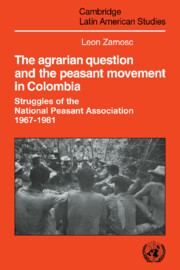 The Agrarian Question and the Peasant Movement in Colombia
The Agrarian Question and the Peasant Movement in Colombia Book contents
- Frontmatter
- Contents
- List of tables, figures, and maps
- Foreword by Tedor Shanin
- Foreword by UNRISD
- Acknowledgments
- List of abbreviations
- Map 1 Republic of Colombia
- Introduction
- 1 The agrarian question in Colombia
- 2 Reformism and the beginnings of the peasant movement
- 3 The radicalization of ANUC and the great waves of land invasions
- 4 Counterreform
- 5 The contradictory influences of peasant politicization
- 6 Concessions and repressive escalation
- 7 The new occupational alternatives and the issue of the rural proletariat
- 8 Partial repeasantization and the question of the new peasant settlements
- 9 Final crisis and clientelist regression of ANUC
- 10 Overview and final remarks
- Notes
- Bibliography
- Index
- Cambridge Latin American Studies
2 - Reformism and the beginnings of the peasant movement
Published online by Cambridge University Press: 10 October 2009
- Frontmatter
- Contents
- List of tables, figures, and maps
- Foreword by Tedor Shanin
- Foreword by UNRISD
- Acknowledgments
- List of abbreviations
- Map 1 Republic of Colombia
- Introduction
- 1 The agrarian question in Colombia
- 2 Reformism and the beginnings of the peasant movement
- 3 The radicalization of ANUC and the great waves of land invasions
- 4 Counterreform
- 5 The contradictory influences of peasant politicization
- 6 Concessions and repressive escalation
- 7 The new occupational alternatives and the issue of the rural proletariat
- 8 Partial repeasantization and the question of the new peasant settlements
- 9 Final crisis and clientelist regression of ANUC
- 10 Overview and final remarks
- Notes
- Bibliography
- Index
- Cambridge Latin American Studies
Summary
The political dimension of the agrarian question in Colombia during the 1960s was dominated by the reformist policies of the National Front. In terms of both purported goals and ideological justification, the political, social, and economic components of the reformist approach usually appear to be tightly integrated. However, when the question is considered in concrete terms, it is always possible to distinguish shades of emphasis in a particular reformist policy. From this point of view, and focusing upon the underlying motivations, two different phases of agrarian reformism under the National Front can be discerned. During the administrations of Alberto Lleras Camargo (1958–1962) and Guillermo León Valencia (1962–1966), the emphasis was clearly upon political imperatives: the movement toward limited agrarian reform was seen as necessary to reestablish peace and rebuild the power of the dominant classes after the civil war. Later, under the government of Carlos Lleras Restrepo (1966–1970), the emphasis was shifted toward the social and economic aspects of reform. As will be seen in the second and third sections of this chapter, peasant support was sought as part of an attempt to carry out a more substantial agrarian reform that would help to overcome the limitations of the existing model of capitalist accumulation.
Agrarian reform and the political outlook for a peasant movement
To understand why political motives predominated during the first phase of agrarian reform, it is necessary to remember the consequences of the civil war in the countryside.
- Type
- Chapter
- Information
- The Agrarian Question and the Peasant Movement in ColombiaStruggles of the National Peasant Association, 1967–1981, pp. 34 - 65Publisher: Cambridge University PressPrint publication year: 1986


